Two closely-related species of shapeshifting fish inhabit the North Atlantic: the American eel, Anguilla rostrata; and the European eel, Anguilla anguilla. They share a catadromous lifestyle, that is, they live in freshwater but breed in saltwater. That’s the opposite of the better-known anadromous fish, like salmon.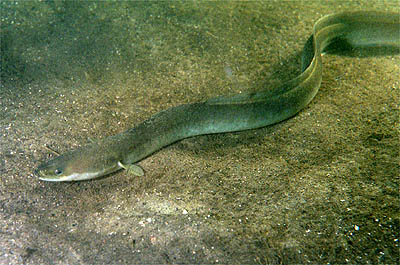 European eel. Photo by Ron Offermans, courtesy Wikimedia Commons.
European eel. Photo by Ron Offermans, courtesy Wikimedia Commons.
Few animals have eluded human understanding for so long as these eels. For centuries, no one knew that a variety of lifeforms found in both fresh and salt water were members of the same species at different stages of a life history:
- leptocephalus
- glass eel
- elver
- yellow eel
- silver eel
After lifespans of perhaps 20 years, maybe many more, the Atlantic eels abandon their riverine or shoreside homes and swim to the Sargasso Sea to spawn. The sexually mature adults, called silver eels, die after spawning.
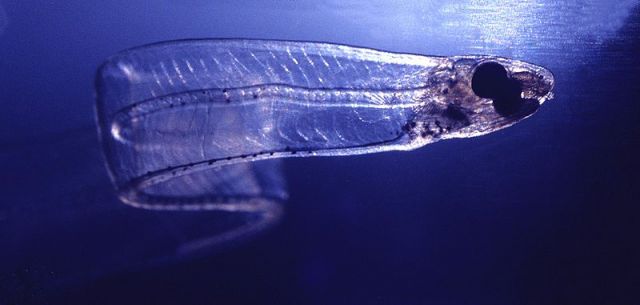 Photo by Uwe Kils, courtesy Wikimedia Commons.In among the sargassum, the fertilized eggs hatch into the ferocious-looking larvae known as a leptocephalus (above). The name is left over from the time, before 1893, when these ~5-centimeter/2-inch-long larvae were considered a species all their own: Leptocephalus brevirostris.
Photo by Uwe Kils, courtesy Wikimedia Commons.In among the sargassum, the fertilized eggs hatch into the ferocious-looking larvae known as a leptocephalus (above). The name is left over from the time, before 1893, when these ~5-centimeter/2-inch-long larvae were considered a species all their own: Leptocephalus brevirostris.
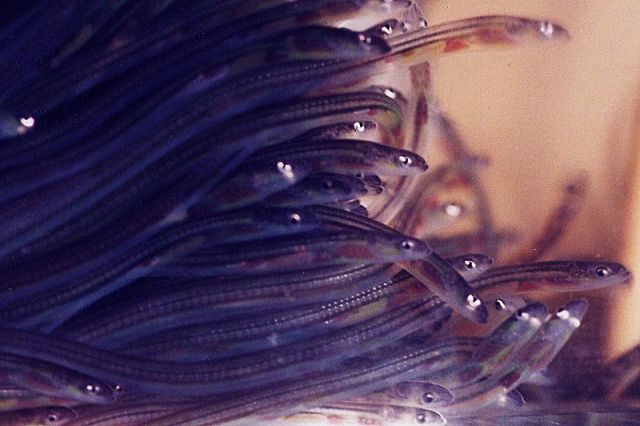 Photo by Uwe Kils, courtesy Wikimedia Commons.Leptocephali larvae metamorphose into juveniles, the glass eels, during their first migration, drifting from their hatching grounds in the Sargasso Sea. The postlarval glass eels in the photo above are still transparent enough that you can see their red gills and hearts.
Photo by Uwe Kils, courtesy Wikimedia Commons.Leptocephali larvae metamorphose into juveniles, the glass eels, during their first migration, drifting from their hatching grounds in the Sargasso Sea. The postlarval glass eels in the photo above are still transparent enough that you can see their red gills and hearts.
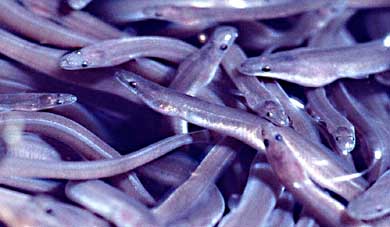 Elvers. Photo by Uwe Kils, courtesy Wikimedia Commons.As glass eels begin to develop coloration, they become known as elvers. By this stage they’ve made riverfall in North America or Europe, depending on their species. Elvers were favorite foods throughout much of old Europe. In his writings from 1679, the British philosopher John Locke (1632-1704) suggested sampling elver-cakes when visiting Bristol. (Perhaps some of the eels’ transformational powers rubbed off, gastronimocally speaking, to influence Locke’s transformed thinking?)
Elvers. Photo by Uwe Kils, courtesy Wikimedia Commons.As glass eels begin to develop coloration, they become known as elvers. By this stage they’ve made riverfall in North America or Europe, depending on their species. Elvers were favorite foods throughout much of old Europe. In his writings from 1679, the British philosopher John Locke (1632-1704) suggested sampling elver-cakes when visiting Bristol. (Perhaps some of the eels’ transformational powers rubbed off, gastronimocally speaking, to influence Locke’s transformed thinking?)
My OED tells me the word eelet was also used for elver, and that the state of being a young elver was known as elverhood.
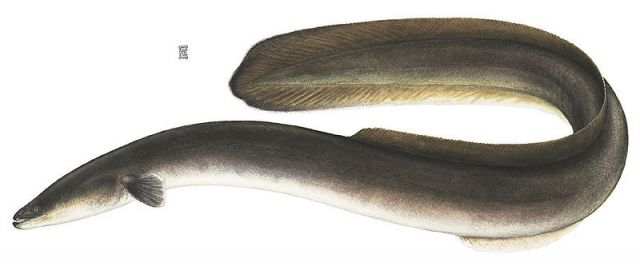 Illustration: Ellen Edmonson and Hugh Chrisp, courtesy Wikimedia Commons.The insoluble problem of eels and elvers was outlined in wonderfully antique language in a 1923 paper to The Royal Society.
Illustration: Ellen Edmonson and Hugh Chrisp, courtesy Wikimedia Commons.The insoluble problem of eels and elvers was outlined in wonderfully antique language in a 1923 paper to The Royal Society.
We know, then, that the old eels vanish from our ken into the sea, and that the sea sends us in return innumerable hosts of elvers. But whither have they wandered, these old eels, and whence have the elvers come? And what are the still younger stages like, which precede the “elver” stage in the development of the eel? It is such problems that constitute the “Eel Question.”
The great eel question befuddled some notoriously fine minds—including Sigmund Freud, who in his student days dissected hundreds of immature eels in search of their elusive male sex organs. Photo by Max Halberstadt courtesy of Wikimedia Commons.
Photo by Max Halberstadt courtesy of Wikimedia Commons.
He eventually quit the eel business to famously spend his post-elverhood dissecting female minds in search of the equally elusive envy of male sex organs.
Many years, countless nautical miles, and some finer science minds later, the strange pieces of the anguillid puzzle began to fall into place. In 1920, Danish biologist Johannes Schmidt (nicknamed Eel-Schmidt… it was he who posed the “Eel Question” in the 1923 paper, above) discovered that Atlantic eels migrate to the Sargasso Sea to spawn. There they join a floating community of life centered around protective drifting forests of sargassum.
BTW, the sargassum weed in this gorgeous bit of film is probably full of leaf-mimic leptocephali too small and too transparent to easily discern. Young eels get caught in the currents swirling around the edges of the ocean gyre that is the Sargasso Sea, and ride with mats of sargassum drifting northwards.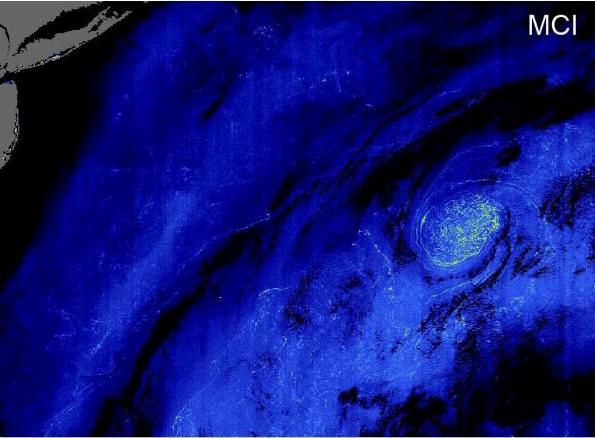 Credit: Jim Gower, Stephanie King, Casey Jones, Institute of Ocean Sciences, Department of Fisheries and Oceans, Sidney, BC Canada. From NASA’s Earth Picture of the Day (EPOD).
Credit: Jim Gower, Stephanie King, Casey Jones, Institute of Ocean Sciences, Department of Fisheries and Oceans, Sidney, BC Canada. From NASA’s Earth Picture of the Day (EPOD).
In the image above, you can see a dense concentration of sargassum trapped in a northbound eddy of the Gulf Stream far off New Jersey. This was the first ever sargassum eddy recorded by satellite. From the EPOD caption:
Here water is shown in blue colors and haze and cloud is dark blue and black. Lighter blue, green and yellow indicate increasing concentrations of weed at the sea surface. The floating weed tends to be concentrated into lines by converging flow. On this day a high concentration of the floating weed has been trapped in a Gulf Stream eddy. Other lines of weed can be seen nearby, stretched along the flow of the Gulf Stream. Satellite data (MERIS Reduced Resolution imagery for 4 Oct 2006) are provided by the European Space Agency—MCI is the Maximum Chlorphyll Index. Our report on the first satellite images of Sargassum weed recorded in the Gulf of Mexico is in press. [I’ve cited their paper, below.]
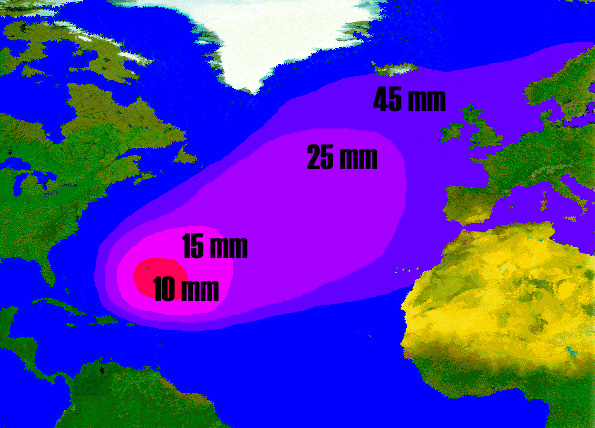 Credit: Uwe Kils, courtesy Wikimedia Commons.European eels spawned in the Sargasso Sea migrate on the North Atlantic’s currents more than 5,000 kilometers/3,100 miles to Europe (above), where they work their way up river systems. Some swim up underground rivers to populate landlocked lakes. The numbers in the graphic reflects the growth of the eels along their migratory route.
Credit: Uwe Kils, courtesy Wikimedia Commons.European eels spawned in the Sargasso Sea migrate on the North Atlantic’s currents more than 5,000 kilometers/3,100 miles to Europe (above), where they work their way up river systems. Some swim up underground rivers to populate landlocked lakes. The numbers in the graphic reflects the growth of the eels along their migratory route.
 Credit: Uwe Kils, courtesy Wikimedia Commons.American eels jump off the currents and work their way inland after shorter migrations (above). New research from those eel leaders, the Danes, just published in Proceedings of the Royal Society B, illustrates the great marriage between oceanic currents, sea surface temperatures, and oceanic migrations, and how all work to disperse some leptocephali larvae to North America and others to Europe—even though their larval ranges overlap, at least in small part, in the Sargasso Sea. The same drivers, apparently, drive the two species differently:
Credit: Uwe Kils, courtesy Wikimedia Commons.American eels jump off the currents and work their way inland after shorter migrations (above). New research from those eel leaders, the Danes, just published in Proceedings of the Royal Society B, illustrates the great marriage between oceanic currents, sea surface temperatures, and oceanic migrations, and how all work to disperse some leptocephali larvae to North America and others to Europe—even though their larval ranges overlap, at least in small part, in the Sargasso Sea. The same drivers, apparently, drive the two species differently:
The small spatial overlap implies that a large proportion of larvae of each species could be in?uenced differently by prevailing hydrography and currents.
From the abstract:
Our ?ndings suggest a key role of oceanic frontal processes, retaining eel larvae within a zone of enhanced feeding conditions and steering their drift. The majority of the more westerly distributed American eel larvae are likely to follow a westerly/northerly drift route entrained in the Antilles/Florida Currents. European eel larvae are generally believed to initially follow the same route, but their more easterly distribution close to the eastward ?owing Subtropical Counter Current indicates that these larvae could follow a shorter, eastward route towards the Azores and Europe. The ?ndings emphasize the signi?cance of oceanic physical-biological linkages in the life-cycle completion of Atlantic eels.
Another paper in the same issue of Proceedings of the Royal Society B, reports the success or failure of nesting loggerhead sea turtles is driven in part by their utilization of the currents—including some of the same currents utilized by the eels—that sweep past their nesting beaches. From the abstract:
For marine animals whose offspring must migrate long distances, natural selection may favour reproduction in areas near ocean currents that facilitate migratory movements. Similarly, selection may act against the use of potential reproductive areas from which offspring have difficulty emigrating. As a first step towards investigating this conceptual framework, we analysed loggerhead sea turtle (Caretta caretta) nest abundance along the southeastern US coast as a function of distance to the Gulf Stream System (GSS), the ocean current to which hatchlings in this region migrate. Results indicate that nest density increases as distance to the GSS decreases… Similar factors may influence patterns of abundance across the reproductive ranges of diverse marine animals, such as penguins, eels, salmon and seals.
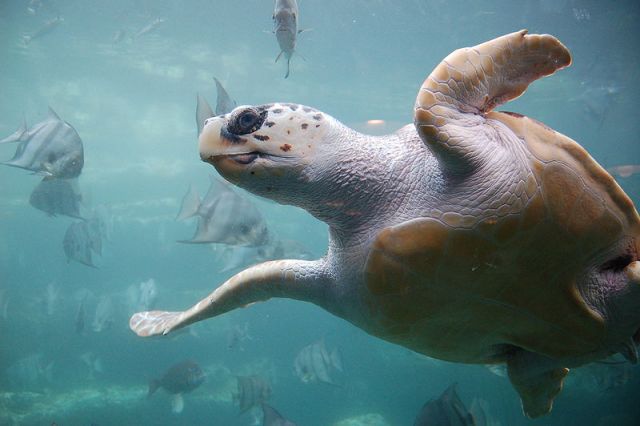 Loggerhead turtle, Caretta caretta. Photo by ukanda, courtesy Wikimedia Commons.The new great eel question is all about their decline. There are 90 to 98 percent fewer European eels now than in the 1970s. Could these travellers be having a hard time finding their optimal “nesting beaches” due to changing ocean conditions?
Loggerhead turtle, Caretta caretta. Photo by ukanda, courtesy Wikimedia Commons.The new great eel question is all about their decline. There are 90 to 98 percent fewer European eels now than in the 1970s. Could these travellers be having a hard time finding their optimal “nesting beaches” due to changing ocean conditions?
Tale of a bucket with a Tail from 5 Gyres on Vimeo.
Or might the leptocephali be suffering from the tons of plastic garbage collecting in their birth-gyre in the Sargasso?
The causes of the eels’ decline are manifold and may be as difficult for us to decipher as their beginnings.
Finally, another new paper in Biology Letters presents findings on the mysterious origins of the anguillid eels… did these species originate in fresh or salt water? From the abstract:
Of more than 800 species of eels of the order Anguilliformes, only freshwater eels (genus Anguilla with 16 species plus three subspecies) spend most of their lives in freshwater during their catadromous life cycle. Nevertheless, because their spawning areas are located offshore in the open ocean, they migrate back to their specific breeding place in the ocean, often located thousands of kilometres away. The evolutionary origin of such enigmatic behaviour, however, remains elusive because of the uncertain phylogenetic position of freshwater eels within the principally marine anguilliforms. Here, we show strong evidence for a deep oceanic origin of the freshwater eels, based on the phylogenetic analysis of whole mitochondrial genome sequences from 56 species representing all of the 19 anguilliform families.
May the cycle never end.
The papers:
- Johannes Schmidt. The Breeding Places of the Eel. Philosophical Transactions of the Royal Society of London. Series B. Vol. 211 (1923), 179-208.
- Jim Gower and Stephanie King. Satellite Images Show the Movement of Floating Sargassum in the Gulf of Mexico and Atlantic Ocean. Nature Proceedings. hdl:10101/npre.2008.1894.1.
- Peter Munk, et al. Oceanic fronts in the Sargasso Sea control the early life and drift of Atlantic eels. Proc. R. Soc. B (2010) 277, 3593–3599. DOI:10.1098/rspb.2010.0900.
- Nathan F. Putman, John M. Bane, andKenneth J. Lohmann. Sea turtle nesting distributions and oceanographic constraints on hatchling migration. Proc. R. Soc. B 7 December 2010 vol. 277 no. 1700 3631-3637. DOI: 10.1098/rspb.2010.1088.
- Jun G. Inoue, et al. Deep-ocean origin of the freshwater eels. Biology Letters. DOI:10.1098/rsbl.2009.0989.
- Tsukamoto K, et al. Migration, speciation, and the evolution of diadromy in anguillid eels. Can. J. Fish. Aquat. Sci. 59, 1989–1998. DOI:10.1139/f02-165.
I ♥ open-access papers.
Crossposted from Deep Blue Home.














